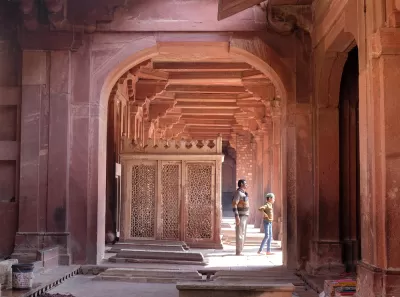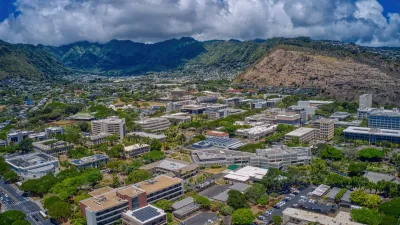Fatehpur Sikri, an example of Mughal architecture in Northern India, has some lessons and reminders for modern architects, writes Indian trained Bay Area architect, artist, and planner Ayub Patel.

On a recent trip to Northern India, Bay Area architect, artist, and planner Ayub Patel visited Fatehpur Sikri, a hilltop fortress and palace built by the Mughal Emperor Akbar the Great. Akbar was a 16th century Indian ruler from the Islamic Mughal dynasty who conquered and united far flung parts of India, including Hindu and Muslim kingdoms. Patel writes of Fatehpur Sikri:
“The drama of movement to and within the complex is heightened by shifting axes, both major and minor, coupled with the courtyard planning principles of the Persians and local Hindus. These amalgamate very well in response to both climate, privacy, and multiple vistas. As one circulates within the ensemble and it’s cleverly designed level changes, one realizes that each building within is different yet somehow extremely well connected to the rest. The ever so subtle yet powerful changes in level that separate forecourt or hind court from building or elevated plinths (that just slightly raise each building above its apron) provide boundaries of definition in a vast continuum of spatial interweave and spatial locks, allowing the onlooker to take in vistas from various vantage points. The dynamics of space within is aided by shifting axes that in some respects provide practical adjustments to the contoured terrain for each piece of the ensemble while gesturing the eye to move on to another potential vista or vantage point. Studies have revealed that the entire complex is planned with proportion based on the Golden Rectangle ratio.”
Patel concludes by quoting:
“It is the manifestation of Aldo Van Eyck’s words ‘Man, after all, breathes both in and out; when will architecture do the same?’”
For more of Patel’s words, drawings, and photos of Fatehpur Sikri, please visit the source article.
FULL STORY: A peek into the timeless past of Mughal architecture in India

Alabama: Trump Terminates Settlements for Black Communities Harmed By Raw Sewage
Trump deemed the landmark civil rights agreement “illegal DEI and environmental justice policy.”

Planetizen Federal Action Tracker
A weekly monitor of how Trump’s orders and actions are impacting planners and planning in America.

The 120 Year Old Tiny Home Villages That Sheltered San Francisco’s Earthquake Refugees
More than a century ago, San Francisco mobilized to house thousands of residents displaced by the 1906 earthquake. Could their strategy offer a model for the present?

In Both Crashes and Crime, Public Transportation is Far Safer than Driving
Contrary to popular assumptions, public transportation has far lower crash and crime rates than automobile travel. For safer communities, improve and encourage transit travel.

Report: Zoning Reforms Should Complement Nashville’s Ambitious Transit Plan
Without reform, restrictive zoning codes will limit the impact of the city’s planned transit expansion and could exclude some of the residents who depend on transit the most.

Judge Orders Release of Frozen IRA, IIJA Funding
The decision is a victory for environmental groups who charged that freezing funds for critical infrastructure and disaster response programs caused “real and irreparable harm” to communities.
Urban Design for Planners 1: Software Tools
This six-course series explores essential urban design concepts using open source software and equips planners with the tools they need to participate fully in the urban design process.
Planning for Universal Design
Learn the tools for implementing Universal Design in planning regulations.
Clanton & Associates, Inc.
Jessamine County Fiscal Court
Institute for Housing and Urban Development Studies (IHS)
City of Grandview
Harvard GSD Executive Education
Toledo-Lucas County Plan Commissions
Salt Lake City
NYU Wagner Graduate School of Public Service





























